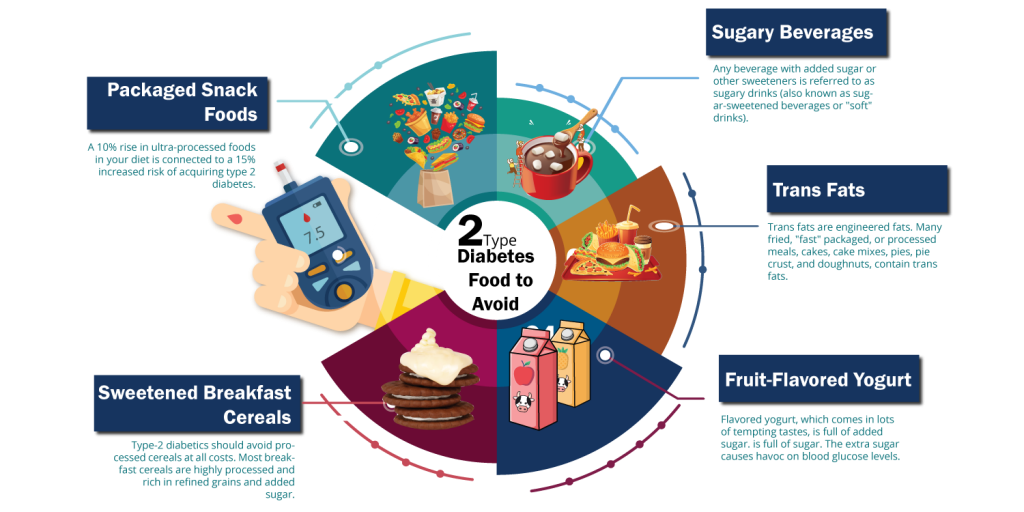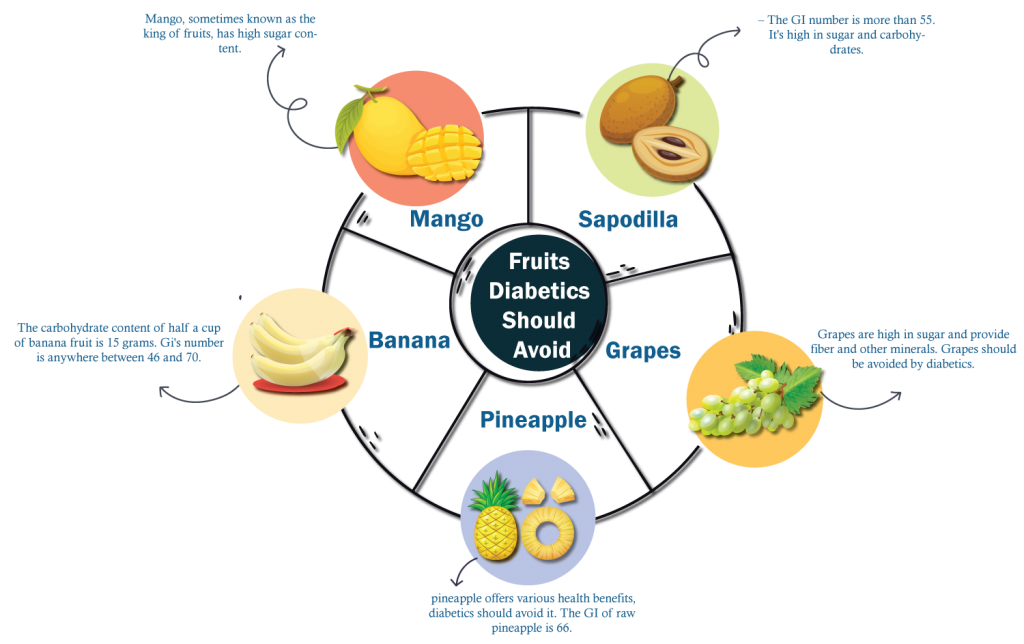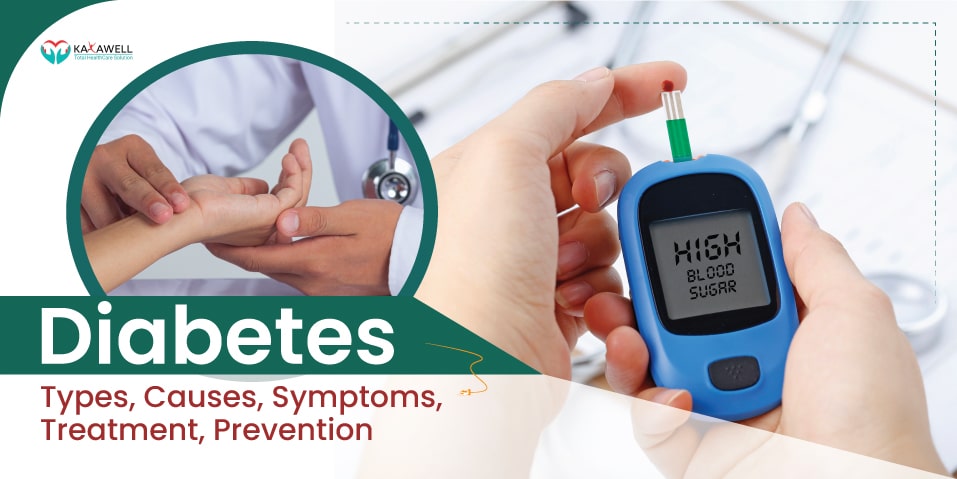When living with type-2 diabetes, the food on your plate matters the most. You should know which diabetes foods to avoid and which to consume. It will help you not only manage your diabetes but also reverse it in the long run.
Food and Type-2 Diabetes: The Relationship
The most prevalent type of diabetes is type 2 diabetes, which develops when blood glucose, commonly known as blood sugar, is too high.
The body gets glucose from the food we eat. In the case of type-2 diabetes, glucose is not converted into energy. Hence, glucose remains in the bloodstream and is under-utilized.
Hyperglycemia, too much sugar in the blood, for long periods can cause serious health problems. If not treated it can impact healthy blood circulation and over time increase the risk of heart disease and stroke, kidney disease, vision problems, and nerve problems.
There is a substantial correlation between diet and type 2 diabetes, especially when combined with bodyweight. A balanced diet helps control type 2 diabetes, reduce type 2 diabetic complications, and aid weight loss.
What Food Causes Diabetes?
As per diabetes clinical research, in 2020, more than 2 billion adults (39% of the adult global population) were overweight. Obesity increases Type 2 diabetes risk by roughly six times compared to people who have a healthy weight. That’s why it’s critical to learn about diabetes food to avoid. But how can you categorize food as good or bad for diabetes?
Experts suggest three parameters to recognize foods that diabetics should avoid:
- Carb Count
- Glycemic Index (GI)
- Glycemic Load (GL)
Let’s discuss them one by one:
Carb Count
The first parameter is carb count. Unlike protein and fat, carbohydrates are quickly broken down into sugar (glucose) and absorbed into the bloodstream. As a result, they have the greatest impact on blood sugar levels.
When diabetics consume too many carbohydrates at once, their blood sugar levels might dangerously rise. Low-carbohydrate diets can help minimize blood sugar spikes and reduce the risk of diabetes complications.
Glycemic Index (GI)
The second parameter is the glycemic index (GI)- a numerical rating that tells how quickly a particular food item raises blood sugar. GI ranges from a scale of 0 to 100, with 100 being pure glucose (sugar). The lower the food’s glycemic index, the slower blood sugar levels rise after consuming it.
Glycaemic Load (GL)
The last parameter is glycaemic load (GL). It tells us the ideal food portions. For diabetics, it’s crucial to keep an eye on the portion size. For example, pasta has a low GI, but a large serving can cause blood glucose levels to rise faster than a smaller serving. The Glycemic Index Foundation suggests maintaining a daily glycemic load under 100 for best health.
Based on the above it is safe to say that diabetics foods to avoid are:
- High in glycemic index (GI)
- Low in GI but high in glycaemic load (GL)
- High carb foods
So keep the above parameters in mind while planning your diet. It will aid in the management as well as reversal of diabetes.
Type 2 Diabetes Food to Avoid
If you are type-2 diabetic or at risk of type-2 diabetes, here is a list of foods that diabetics should avoid:

1. Sugary Beverages
Any beverage with added sugar or other sweeteners is referred to as sugary drinks (also known as sugar-sweetened beverages or “soft” drinks). Soda, pop, cola, tonic, fruit punch, lemonade, sweetened powdered drinks, and sports and energy drinks all are ill-advised.
People who routinely consume sugary drinks—1 to 2 cans per day or more—have a 26 percent higher chance of getting type 2 diabetes than those who do not.
2. Trans Fats
Trans fats are engineered fats. Many fried, “fast” packaged, or processed meals, cakes, cake mixes, pies, pie crust, and doughnuts, contain trans fats.
Trans fat is the worst type of fat for diabetes. Possibly the worst!
They are not processed efficiently by our bodies, therefore they linger in the bloodstream longer. They raise bad cholesterol while lowering good cholesterol in the body.
Trans fats raise the risk of heart disease, the major cause of death in adults. They are also linked to inflammation and obesity in adults.
3. Fruit-Flavored Yogurt
Flavored yogurt, which comes in lots of tempting tastes, is full of added sugar. is full of sugar. The extra sugar causes havoc on blood glucose levels.
You should avoid flavored yogurt and go for plain yogurt instead. The best yogurt is plain, nonfat yogurt. Protein, calcium, and probiotics are abundant in whole milk and Greek-style yogurt.
4. Sweetened Breakfast Cereals
Type-2 diabetics should avoid processed cereals at all costs. Most breakfast cereals are highly processed and rich in refined grains and added sugar.
Sweetened breakfast cereals contribute to weight gain, diabetes risk, and elevated blood pressure. Furthermore, a high-sugar breakfast affects blood sugar levels and energy levels throughout the day.
5. Packaged Snack Foods
According to research, a 10% rise in ultra-processed foods in your diet is connected to a 15% increased risk of acquiring type 2 diabetes. Preservatives and sweeteners are abundant in processed meals, and they are the primary causes of heart disease and blood sugar elevation.
Which Fruits Should Diabetics Avoid?
Each fruit has a different capacity to change the sugar level in the blood of the diabetic. As a diabetic, to stay on the safer side, it is wise to avoid some fruits. This is because some fruits can quickly raise the sugar level in the blood.
So what fruits diabetics should avoid?
The fruits with a glycemic index between 70 and 100 are rich in sugar, and hence they should be avoided or eaten in moderation:

- Mango – Mango, sometimes known as the king of fruits, has high sugar content. One mango contains 46 grams of sugar, making it a poor choice if you’re attempting to lose weight or limit your sugar intake.
- Sapodilla (Chikoo or sapota) – The GI number is more than 55. It’s high in sugar and carbohydrates.
- Grapes – Grapes are high in sugar and provide fiber and other minerals. Grapes should be avoided by diabetics. A cup of these has approximately 23 grams of sugar.
- Banana – The carbohydrate content of half a cup of banana fruit is 15 grams. Gi’s number is anywhere between 46 and 70. Bananas are safe but only if eaten in moderation.
- Watermelon – Watermelon has a low glycemic load despite its high GI rating. It has fewer calories and less fiber. Vitamins A and C are abundant. After eating a slice or two, a person’s blood sugar levels will only be slightly affected.
- Pineapple –Although pineapple offers various health benefits, diabetics should avoid it. The GI of raw pineapple is 66. To decrease the fruit’s blood sugar impact, eat it in moderation and couple it with protein or healthy fat like nuts or avocado.
Breaking The Fruit Myth
Finding the appropriate balance for each meal of the day is the key to diabetes management and prevention. As long as the portion size is small and low on carbs, nothing is off-limits.
When it comes to fruits diabetics should avoid, stay away from canned fruit\ syrup or juice.
Eat fresh natural fruits only. Packaged fruit juices contain more carbohydrates, have added flavors and can raise blood sugar levels faster than fresh fruits.
Why Carb-Count Matter?
Carbohydrates are one of the three main nutrients contained in diets, along with proteins and fats. However, consuming too many carbohydrates is unhealthy. It’s the carb count that most people get wrong when it comes to type 2 diabetes foods to avoid.
Carbs promote more insulin secretion than proteins or fats, and insulin causes the body to store fat, leading to a host of other disease states. High carb foods, even with a low GI, are calorie-dense and therefore fattening. If not eaten in moderation, High carb foods can:
- Lead to obesity
- Cause abnormal blood sugar spikes
- Impact heart health
If you are wondering, what carbs to avoid? Here’s an article to help you.
Diabetic Neuropathy and Its Effect on Health
High blood sugar causes diabetic neuropathy, which is a type of nerve damage (glucose). The most common sign of diabetic neuropathy is nerve loss in the legs and feet.
Depending on which nerves are affected, diabetic neuropathy symptoms can range from leg and foot pain to digestive, urinary tract, blood vessel, and heart problems. Some folks encounter just minor symptoms. Diabetic neuropathy, on the other hand, can be excruciatingly painful and incapacitating.
Diabetic neuropathy is a serious diabetic condition that affects up to half of all diabetics. Diabetic neuropathy can usually be avoided or slowed with adequate blood sugar management and a healthy lifestyle.
Type 2 Diabetes Complications
Complications of type 2 diabetes can be extremely dangerous if untreated and unchecked. Diabetes is a degenerative disease.
- When your blood sugar levels are high, the sugars attack and damage your organs.
- When your blood sugar levels are high and you have an injury, the healing process is slowed.
The complications wear on your brain, eyes, heart, kidneys, and other organs. Diabetics who do not control their blood sugars risk losing their vision, developing renal failure, losing limbs to gangrene, and suffering strokes and heart attacks.
How to Prevent Diabetes?
If you want to avoid diseases like diabetes, you must live a healthy lifestyle. Here are some pointers to help you avoid diabetes:
- Morning walks of at least 1 hour are recommended.
- If you consume too much sugar, reduce your consumption.
- If you are overweight, keep your weight under control.
- Eat fresh fruits instead of juice.
- Consult your health expert and dietician regularly.
The Bottomline
Patients with diabetes must be more rigorous in controlling their blood sugar levels. The idea is to restrict your food and adopt a better lifestyle.
It is critical to adopt a low-carbohydrate, healthful diet to manage diabetes. Low-carb diets have been shown in studies to effectively manage type 1 and type 2 diabetes. Low-carb diets can help with blood sugar control, lowering medication requirements and lowering the risk of diabetes complications.
Learning how to measure carbohydrates is essential for diabetic treatment. Maintaining insulin levels requires food balance. Make sure to include a variety of fruits, vegetables, protein, and healthy fats in each meal. It is critical to pay close attention to the carbs chosen.
If you haven’t yet figured out diabetic foods to avoid, it’s time to talk to an expert. At Kayawell, we make it extremely easy for you to connect with diet experts near you. With just a few clicks, you will have all the information you need to live healthy and better with diabetes.

Leave a Reply
You must be logged in to post a comment.